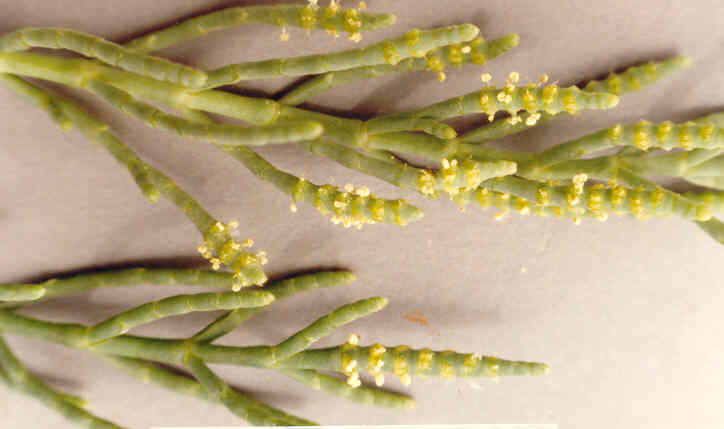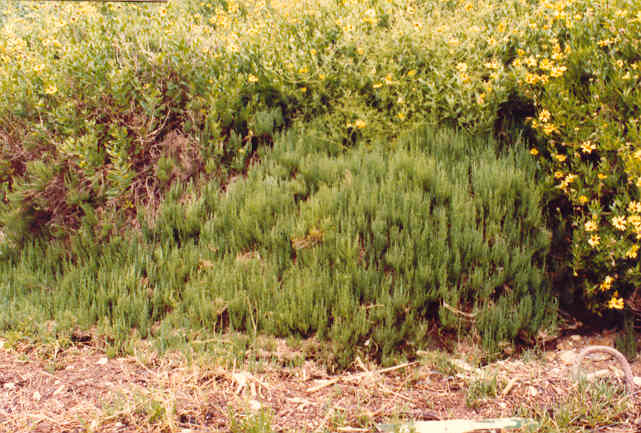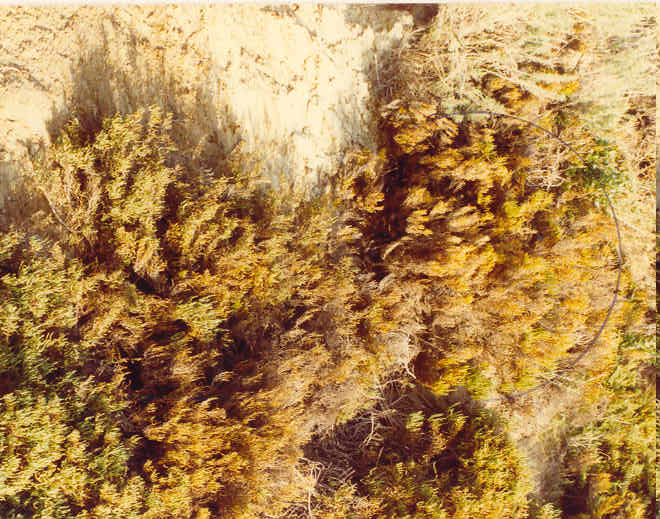
Arthrocnemum subterminalis (Parish) Standl
=Salicornia subterminalis Parish
Chenopodiaceae (Goosefoot Family)
Native
 |
Arthrocnemum subterminalis (Parish) Standl=Salicornia subterminalis ParishChenopodiaceae (Goosefoot Family)Native
GlasswortPickleweedParish's Pickleweed |
May Photo
Plant Characteristics:
Perennial with succulent, leafless, jointed stems; stems widely spreading
or erect and compact, opposite, 1.5-3 dm. high, the joints 2-20 mm. long;
branchlets many, crowded, 2-3 mm. in diam., the joints 5-15 mm. long; spikes
2-3.5 cm. long, 2-2.5 mm. thick at
base, with few to several lf. bearing scales below and as many slender sterile
ones above; fls. subequal; calyx fleshy, with a truncate or 3-4 toothed margin;
seeds glabrous, brown, ca. 1 mm. long.
Habitat:
Coastal Salt Marsh, Alkali Sink, etc.; San Francisco Bay and San Joaquin
V. to Mex.; some Channel Ids. and inland to Perris, Riverside Co. Below 800 m.
April-Sept.
Name:
Greek, sal, salt and cornu, a horn, being saline plants with hornlike branches.
(Munz, Flora So. Calif. 367).
The common name, Glasswort comes from the high soda content of the plant
which was of value to the glass and soap manufacturers.
(Clarke 165). Latin, sub,
prefix meaning under, below and terminis,
end. (Jaeger 251,260). Refers
to the characteristic of the plant in which it produces terminal fls. that
become subterminal as the plant continues to grow new jointed stems.
The origin of genus name Arthrocnemum
is unknown. (my comment).
General:
Very common in the study area. Photographed
on North Star Beach and the Castaway's Bluffs.
(my comments). Pickleweed
seeds, which are available in summer, were a favorite with the Cahuillas, the
inhabitants of the Colorado Desert, the San Jacinto and San Bernardino
Mountains, however, the Cahuillas of the
mountain areas do not appear to recall the plant. Barrows (1900:57) said it grew abundantly in the Indian Wells
area of the Coachella Valley. (Bean
and Saubel 135).
The Indians of Utah and Nevada gathered the seeds and ground them into
flour. Pickles were made by the
colonists by first boiling the stems in salted water, then soaking them in
vinegar. The bright green tender
tips of the plant are used in seaside salads.
It can be used as a potherb, but is not as tasty in that use. "Of the four species that occur throughout the state, this
particular species tastes best to me". (Clarke
164, 165). The
flowering spikes are terminal but often become subterminal because of continued
growth and branching above the fertile part.
(Mason 451).
One of the native halophytes found in Upper Newport Bay.
(Zedler 16). (See Spartina
foliosa for a complete list of these halophytes).
S. subterminalis is common at the highest intertidal marsh habitats and
does not occur in marshes above Morro Bay.
It appears to be both salt tolerant and drought tolerant; it occurs
adjacent to salt pans and in areas above extreme highwater or behind dikes which
prevent tidal inundation. (Zedler
30). More than 70 percent of the species
will be found between 6.6 and 6.8 ft. above MLLW. (Zedler 17)
Mason does not list S. subterminalis
in his book and makes the following comment.
"We have followed Standley in regarding Arthrocnemum
as distinct from Salicornia because of
the indeterminate growth of the flowering shoot, the presence of abundant
endosperm in the
Text Ref:
Abrams, Vol. II 91; Hickman, Ed. 514; Mason 451; Munz, Calif Flora 382; Munz, Flora
So. Calif. 368; Roberts 18.
Photo Ref:
April 1 83 # 2,3; June 4 83 # 15; May 2 87 # 8A.
Identity by R. De Ruff,
confirmed by G. Marsh.
First Found: April 1983.
Computer Ref: Plant Data 226.
Have plant specimen.
Last edit 6/6/04.
 |
 |
April Photo December Photo